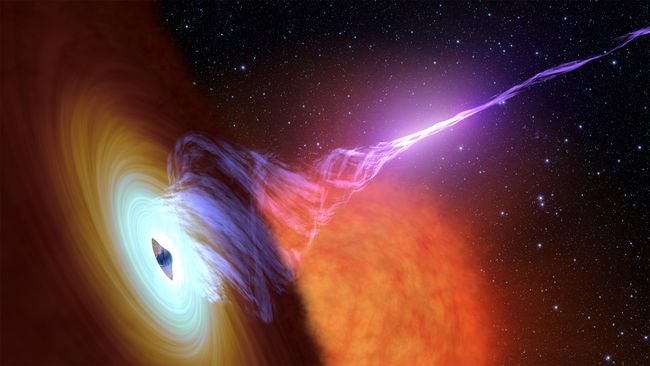A recent paper suggests that the predictions made by Einstein imply the existence of uncommon ‘gravitational lasers’ in various parts of the universe.
A recent study, which merges two of Albert Einstein’s renowned predictions, proposes that distortions in the fabric of space-time can unite to form ‘gravitational lasers’, emitting from black holes in unpredictable trajectories throughout the universe.

Albert Einstein, known for his numerous theoretical insights, made predictions about two phenomena in our universe that have been proven true: gravitational waves and stimulated emission of radiation. Recent research has discovered that these effects can occasionally combine to form rare and extraordinary “gravitational lasers,” which could potentially provide a new method for detecting one of the most elusive substances in the universe.
Stimulated emission of radiation, which occurs daily in the form of lasers such as barcode scanners in local supermarkets or fiber-optic cables transmitting information throughout cities, is a phenomenon experienced by all. Within a laser, atoms emit radiation at a specific wavelength, stimulating nearby atoms to release radiation of the same wavelength. This process continues until the radiation becomes a coherent beam, which is the laser’s output. Astronomers have also identified natural sources of lasers, particularly in massive cold molecular clouds, where they are referred to as masers due to their emission of microwave radiation.
In a paper published on the preprint database arXiv in January, physicist Jing Liu from the University of Chinese Academy of Sciences in Beijing proposes that gravity itself could be harnessed to create a cosmic laser beam. However, this would only be possible if a specific model of dark matter, the enigmatic and invisible substance that constitutes approximately 85% of the matter in the universe, is accurate.
This particular model of dark matter is centered around axions, which are hypothetical particles that are extremely light and are believed to permeate the entire universe. Due to their lightness, these particles possess distinct quantum properties, resulting in their wavelengths being quite large. Rather than behaving solely as particles, they exhibit a peculiar combination of wave-like and particle-like characteristics.
The wave-like nature of axions enables them to be captured by black holes. However, due to their large wavelengths, they cannot fit within the event horizon of a black hole. Instead of falling into the black hole, axions exist in the vicinity of it, similar to how electrons exist near the nucleus of an atom. Physicists have postulated that these “black hole atoms” may be scattered throughout the universe.
Simultaneously, black holes themselves emit gravitational waves, which are essentially ripples in the fabric of space-time. While astronomers have already detected gravitational waves emitted by merging black holes, the intricate interactions between solitary black holes and their surroundings can also result in wave emission.
If the wavelengths of the gravitational waves align perfectly (and assuming that the black hole emits a sufficient amount of gravitational waves), they can stimulate the axions surrounding the black hole. Consequently, these axions would begin to move in a synchronized manner, triggering the release of even more gravitational waves.
These newly generated gravitational waves would then lead to further excitations, causing a cascading effect similar to that of a laser. As a result, tightly focused gravitational waves would be emitted in a specific direction. Liu, the scientist who coined the term “gravitational laser” to describe this theoretical phenomenon, emphasized that this would represent an entirely novel type of gravitational wave signal, unlike anything we have previously observed or studied.
Although possessing immense power, gravitational lasers are expected to be extremely scarce. The occurrence of an excitation cascade would necessitate precise conditions, which are unlikely to be frequently met. Additionally, the majority of lasers would be directed away from Earth, as they emanate from black holes in unpredictable orientations, rendering them invisible to us. However, there is a possibility that upcoming gravitational wave observatories could potentially identify gravitational lasers. If such lasers are observed, it would provide substantial proof of the existence of dark matter in the form of axions. Moreover, it would demonstrate the remarkable nature of our universe, which allows for the existence of gravitational lasers.
Do not forget to share your opinion with us to provide you with the best posts !



0 Comments